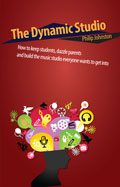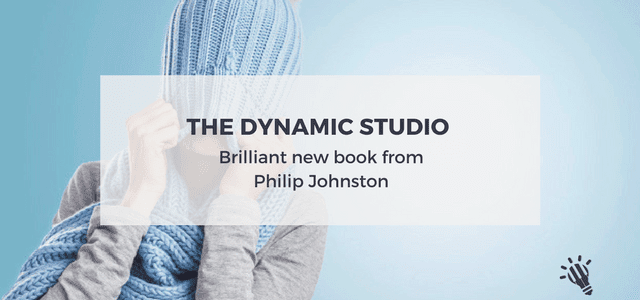
So asks Australian author and music teacher Philip Johnston in his new book “The Dynamic Studio“. Let’s face it, most of us teach the way we were taught and don’t think all that much about whether it’s actually effective anymore. The world is different, kids are certainly different, the internet and mobile communications and hand-held devices are changing everything about living, learning and life generally. This is when Johnston steps in and challenges you to think about whether your studio might actually be stuck in the 1900s and how you can go about making it more dynamic and exciting for your 21st Century students.
I’ve previously blogged about his other books including The Practice Revolution and Scales Bootcamp. The Dynamic Studio continues in his light-hearted, user-friendly and packed-full-of-ideas format. In fact, it’s one of those books that should be read at a table with a notepad handy – you’ll literally find great ideas on every page. The only problem is working out how to use them all!
Even if you feel your studio is running just fine: lots of students, good results and happy parents, take a look. I guarantee you will still pickup hundreds of great new ideas that you wouldn’t have even considered on your own.
For example, Johnston talks about simple measures you can take to spice up your lessons including changing the order of proceedings, changing the physical layout of your room, changing how you ask students to practice, building on pieces through transposition, giving students “wow-I’ve-never-done-this-before” ways of playing and practising, reconsidering targets and goals (are exams, recitals and competitions the only end points?), and many more.
He also talks about studio diversification and compares his approach to that of the computer game industry and businesses needing to stay in the market. He got me thinking about whether running some extra “clubs” outside normal lesson time might not only be good for my students but my studio too. Things like “The Hardcore Sightreading Club”, “The Power Practice Group”, “Club Impossible” or the “Extreme Scales Society”! (I love his use of wacky names to excite students about otherwise mundane activities.)
One thing Johnston does best is to ask a seemingly simple and straightforward question at the start of a chapter, and then proceed to make you realise how little you’ve really thought about the answer! For example, at the start of one chapter he asks, “What is there for your students to do in your studio?”. Ummm how about “play piano??” No, that’s way too narrow-minded; Johnston quickly blows you away with idea after idea that you’ve never thought possible or even connected with music teaching but that are all incredibly useful, fun, interesting and pedagogically sound.
There is a great summary of some of the ideas in the book on Johnston’s website: Inside Music Teaching, which incidentally is full of a whole lot more fantastic teaching information. The Dynamic Studio is available now in paperback and Kindle editions from Amazon.
If there’s one book to buy to enhance your teaching this year, it’s this one!
Disclaimer: I received a complimentary copy of this book for review purposes. I was not required to write a favourable review, nor was I compensated in any other way. All opinions expressed are my own.

HookTheory – hands down THE BEST new resource for music … | Studio News says:
[…] The Dynamic Studio – brilliant new book from Philip JohnstonAMEB announces PD for teachers in 2013The Real Reason Teens are Quitting Your Studio – Part 1Crotchets, Quavers, and Minims…Piano Worksheets With UK Vocabulary | Susan Paradis […]
88pianokeys says:
Wow, Tim, great minds think alike. I just posted a blog about my new online book club and the first book on the agenda is The Dynamic Studio…would love to have you and your readers chime in. Here’t the post for more details: http://88pianokeys.me/2013/02/28/philip-johnston-online-book-club-and-sweepstakes/
leiaslessons says:
This was one of the best teaching books I’ve ever read!